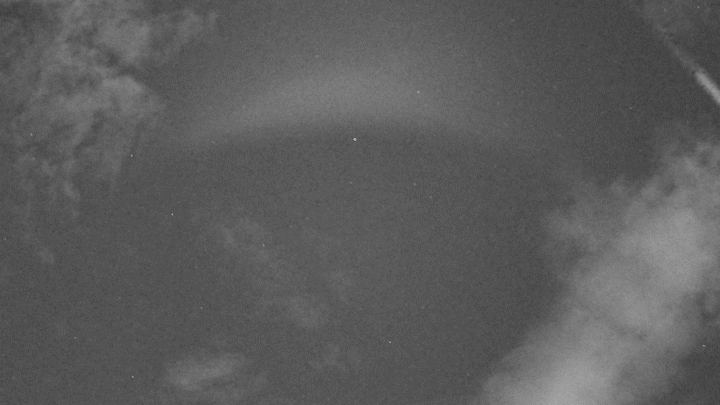Landscapes of the Arctic from a Southern City
BY ANDREW BATEMAN
The GIF (series of images) above was generated with five hundred images taken by a “critter cam,” a cheap infrared camera triggered by a motion sensor or programmed for a time-lapse and used by hunters to locate wildlife hotspots. These images were generated in Toronto during the fall of 2021 from the roof of my home and in collaboration with a friend and colleague, Ella Tetrault. Our goal was to create visualizations of Toronto’s biannual bird migration, a phenomenon that sees 50 million birds intersect over Toronto’s skyline as they travel to and from their breeding grounds, some of which are as far north as Ellesmere Island, within the Arctic Archipelago. They are also a part of my visual interventions into what is considered Arctic landscapes.
Besides a pigeon flying into the camera’s field of view shortly after sunrise, the effort failed to produce any images of migratory birds in flight. Instead, the camera captured planes tracking a flight path on their descent to Pearson International Airport, weather systems moving overhead, and indiscernible objects (probably bugs), manifested on the images as faint zigzagged or curved lines. And yet these images, I argue, deterritorialize the Arctic and activate the imagination to implicate southern settlers in Canadian Arctic realities.
“Cities are killers,” Nigel Thrift proclaims, “but it doesn’t have to be like this” (Thrift 2021, ix-x). Cities that are thousands of kilometers from the Arctic circle are nevertheless intricately entangled with the region’s socio-economic, political and environmental fabric. Pointing a lens at these cities brings focus to specific landscapes, institutions, or instances causing issues for the Arctic region – indeed, my dissertation argues that one should look away from the Arctic to understand it in new light. For instance, Barcelona, Beijing, Milan, and Seoul are capital cities of countries who have observer status on the Arctic Council, allowing them to propose projects and contribute funds for up to 50% of a project’s costs. It requires little imagination to speculate on how lobbying and diplomacy play out in this scenario.
The city I call home, Toronto, is one of the largest cities to be found in the eight Arctic countries, but it is not Canada’s capital, and it is far from figuring in the Arctic imaginary. Its entanglements with the region, however, cannot be dismissed. Two nuclear power plants operate within 70 kilometers of the city centre and release fractional amounts of radioactive tritium that drift into Arctic regions and end up in the Arctic’s flora and fauna. The effects of this migration have yet to be studied by researchers (Brinkmann 2020). Geographic Information System frameworks (used to gather and analyze geographic data) were developed by a Toronto researcher and his PhD student to identify and categorize Arctic plants subject to weather conditions similar to those on Mars as a way to identify plants suitable for terraforming the Red Planet (Vaz and Penfound 2020). And city policies from the 1950s allowed portions of Lake Ontario to be infilled with demolition waste, ultimately resulting in an unintended and important, but nonetheless imperiling (Foster 2007), urban ecological wildlife reserve that provides shelter to Arctic birds overwintering on Lake Ontario – species that leave the comforts of this downtown reserve face the threat of intolerant city dwellers, city policies, and inhospitable human infrastructure (ibid.).
As a documentary filmmaker and photographer, there is a straightforward project here: find the Arctic in Toronto and create a vignette film or a photo essay. However, the GIF above is more exciting to me. It’s a landscape of the Arctic from a southern city that shows you nothing of the arctic, little of the city, and just traces of what may or may not be birds. In a way, the GIF imitates the project. Both ask you to look at something and imagine an entirely different place or phenomenon: look at this Arctic landscape where dense city infrastructure dominates; find the 50 million birds in this grainy GIF of moving clouds and descending airplanes. Both the overall project and the images above require you to activate the imagination to empathize with this unseen phenomenon, a handy exercise if we are to take seriously the issues of slow violence (Nixon 2011), hyperobjects (Morton 2013), or simply the looming threat of global warming.
References
Brinkmann, Lars. 2020. “NIRB Application for Screening # 125500: Predicting Environmental Health Risk from Radioactivity in the Canadian Arctic.” Cambridge Bay, NU: Nunavut Impact Review Board. https://www.nirb.ca/project/125500.
Foster, Jennifer. 2007. “Toronto’s Leslie Street Spit: Aesthetics and the Ecology of Marginal Land.” Environmental Philosophy 4 (1 & 2): 117–34.
Morton, Timothy. 2013. Hyperobjects: Philosophy and Ecology after the End of the World. Minneapolis, MN: University of Minnesota Press.
Nixon, Rob. 2011. Slow Violence and the Environmentalism of the Poor. Cambridge, MA: Harvard University Press.
Thrift, Nigel. 2021. Killer Cities. Thousand Oaks, CA: SAGE Publications.
Vaz, Eric, and Elissa Penfound. 2020. “Mars Terraforming: A Geographic Information System.” Life Sciences in Space Research 24 (December 2019): 50–63. https://doi.org/10.1016/j.lssr.2019.12.001.
Andrew Bateman is a documentary media artist and a PhD Candidate in the Communication and Culture Program at York University and X University in Toronto. He also holds an MFA in Documentary Media from X University. His research-creation PhD project, Landscapes of the Arctic from a Southern City, unravels the myriad connections between Toronto and the Canadian Arctic to challenge the visual lexicon of Arctic documentary work and locate targets for political pressure in areas relevant but not associated with the Arctic. He is the founding member and former co-director of programming for SORCE, an inter-university research-creation collective in Toronto that supports graduate research-creation projects, and his work has been exhibited and screened in Toronto, Berlin, Brussels, Istanbul, and Portland, among other places. He is the recipient of the prestigious Joseph-Armand Bombardier Canada Graduate Doctoral Scholarship.

